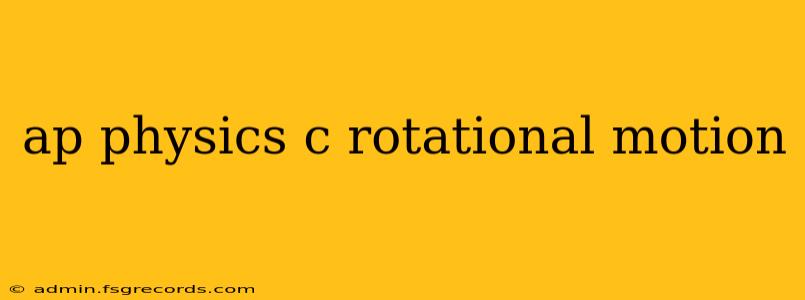Rotational motion, a cornerstone of AP Physics C mechanics, can initially seem daunting. However, with a structured approach and a solid understanding of the underlying principles, you can master this crucial topic and significantly improve your exam score. This guide breaks down the key concepts, equations, and problem-solving strategies to help you conquer rotational motion.
Understanding the Fundamentals: From Linear to Rotational
Before diving into the complexities of rotational dynamics, it's crucial to establish a strong connection between linear and rotational motion. Many concepts have direct rotational analogs:
- Linear Displacement (x): Corresponds to Angular Displacement (θ), measured in radians.
- Linear Velocity (v): Corresponds to Angular Velocity (ω), measured in radians per second (rad/s).
- Linear Acceleration (a): Corresponds to Angular Acceleration (α), measured in radians per second squared (rad/s²).
This analogy is fundamental for understanding the rotational equivalents of Newton's Laws and energy principles.
Key Equations for Rotational Motion:
Several key equations govern rotational motion. Mastering these is essential for solving a wide range of problems:
- θ = ωᵢt + ½αt²: This equation relates angular displacement (θ), initial angular velocity (ωᵢ), angular acceleration (α), and time (t). It's the rotational equivalent of the linear kinematic equation x = vᵢt + ½at².
- ωf = ωᵢ + αt: This equation connects final angular velocity (ωf), initial angular velocity (ωᵢ), angular acceleration (α), and time (t). It mirrors the linear equation vf = vi + at.
- ωf² = ωᵢ² + 2αθ: This equation is useful when time is not explicitly given and relates final angular velocity, initial angular velocity, angular acceleration, and angular displacement.
Torque: The Rotational Force
Torque (τ), the rotational equivalent of force, is the agent of change in rotational motion. It's defined as the product of the force applied and the lever arm (the perpendicular distance from the pivot point to the line of action of the force):
τ = rFsinθ
Where:
- τ is the torque
- r is the lever arm (radius)
- F is the force applied
- θ is the angle between the force vector and the lever arm
Understanding torque is crucial for analyzing rotational equilibrium and dynamics.
Moment of Inertia: Rotational Mass
Moment of inertia (I) is the rotational equivalent of mass. It represents an object's resistance to changes in its rotational motion. The moment of inertia depends on the object's mass distribution and its axis of rotation. Different shapes have different formulas for calculating their moment of inertia. Common examples include:
- Solid cylinder/disk: I = ½MR²
- Hollow cylinder/ring: I = MR²
- Solid sphere: I = (2/5)MR²
- Hollow sphere: I = (2/3)MR²
Rotational Kinetic Energy and Angular Momentum
Rotational kinetic energy (KErot) is the energy an object possesses due to its rotation:
KErot = ½Iω²
Angular momentum (L) is a measure of an object's rotational motion and is conserved in the absence of external torques:
L = Iω
Understanding rotational kinetic energy and angular momentum is essential for solving problems involving energy conservation and angular momentum conservation.
Problem-Solving Strategies
Mastering rotational motion requires consistent practice. Here are some tips for approaching problems effectively:
- Draw a diagram: Visualizing the problem is crucial. Clearly label forces, distances, and angles.
- Identify the knowns and unknowns: What information is given, and what needs to be determined?
- Choose the appropriate equations: Select the equations that relate the knowns and unknowns.
- Solve for the unknown: Use algebraic manipulation to solve for the desired quantity.
- Check your answer: Does your answer make physical sense? Are the units correct?
Advanced Topics
Beyond the fundamentals, AP Physics C also covers more advanced topics like:
- Rolling motion: Combining translational and rotational motion.
- Work and energy in rotational motion: Calculating work done by torques.
- Rotational dynamics with multiple objects: Analyzing systems with interconnected rotating objects.
By mastering these concepts and practicing consistently, you can confidently tackle the challenges of rotational motion in AP Physics C and achieve a high score on the exam. Remember to consult your textbook and seek help from your teacher or tutor when needed. Good luck!

